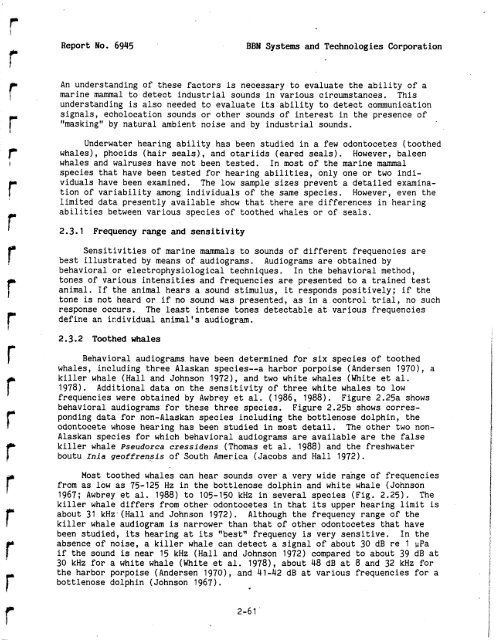Analysis and Ranking of the Acoustic Disturbance Potential of ...
Analysis and Ranking of the Acoustic Disturbance Potential of ...
Analysis and Ranking of the Acoustic Disturbance Potential of ...
You also want an ePaper? Increase the reach of your titles
YUMPU automatically turns print PDFs into web optimized ePapers that Google loves.
Report No. 6945<br />
BBN Systems <strong>and</strong> Technologies Corporation<br />
An underst<strong>and</strong>ing <strong>of</strong> <strong>the</strong>se factors is necessary to evaluate <strong>the</strong> ability <strong>of</strong> a<br />
marine mammal to detect industrial sounds in various circumstances. This<br />
underst<strong>and</strong>ing is also needed to evaluate its ability to detect communication<br />
signals, echolocation sounds or o<strong>the</strong>r sounds <strong>of</strong> interest in <strong>the</strong> presence <strong>of</strong><br />
"masking" by natural ambient noise <strong>and</strong> by industrial sounds.<br />
Underwater hearing ability has been studied in a few odontocetes (too<strong>the</strong>d<br />
whales), phocids (hair seals), <strong>and</strong> otariids (eared seals). However, baleen<br />
whales <strong>and</strong> walruses have not been tested. In most <strong>of</strong> <strong>the</strong> marine mammal<br />
species that have been tested for hearing abilities, only one or two individuals<br />
have been examined. The low sample sizes prevent a detailed examination<br />
<strong>of</strong> variability among individuals <strong>of</strong> <strong>the</strong> same species. However, even <strong>the</strong><br />
limited data presently available show that <strong>the</strong>re are differences in hearing<br />
abilities between various species <strong>of</strong> too<strong>the</strong>d whales or <strong>of</strong> seals.<br />
2.3.1 Frequency range <strong>and</strong> sensitivity<br />
Sensitivities <strong>of</strong> marine mammals to sounds <strong>of</strong> different frequencies are<br />
best illustrated by means <strong>of</strong> audiograms. Audiograms are obtained by<br />
behavioral or electrophysiological techniques. In <strong>the</strong> behavioral method,<br />
tones <strong>of</strong> various intensities <strong>and</strong> frequencies are presented to a trained test<br />
animal. If <strong>the</strong> animal hears a sound stimulus, it responds positively; if <strong>the</strong><br />
tone is not heard or if no sound was presented, as in a control trial, no such<br />
response occurs. The least intense tones detectable at various frequencies<br />
define an ir.dividua1 animal's audiogram.<br />
2.3.2 Too<strong>the</strong>d whales<br />
Behavioral audiograms have been determined for six species <strong>of</strong> too<strong>the</strong>d<br />
whales, including three Alaskan species--a harbor porpoise (Andersen 1970), a<br />
killer whale (Hall <strong>and</strong> Johnson 1972), <strong>and</strong> two white whales (White et al.<br />
1978). Additional data on <strong>the</strong> sensitivity <strong>of</strong> three white whales to low<br />
frequencies were obtained by Awbrey et al. (1986, 1988). Figure 2.25a shows<br />
behavioral audiograms for <strong>the</strong>se three species. Figure 2.25b shows corresponding<br />
data for non-Alaskan species including <strong>the</strong> bottlenose dolphin, <strong>the</strong><br />
odontocete whose hearing has been studied in most detail. The o<strong>the</strong>r two non-<br />
Alaskan species for which behavioral audiograms are available are <strong>the</strong> false<br />
killer whale Pseudorca cressidens (Thomas et al. 1988) <strong>and</strong> <strong>the</strong> freshwater<br />
boutu Inia ge<strong>of</strong>frensis <strong>of</strong> South America (Jacobs <strong>and</strong> Hall 1972).<br />
Most too<strong>the</strong>d whales can hear sounds over a very wide range <strong>of</strong> frequencies<br />
from as low as 75-125 Hz in <strong>the</strong> bottlenose dolphin <strong>and</strong> white whale (Johnson<br />
1967; Awbrey et al. 1988) to 105-150 kHz in several species (Fig. 2.25). The<br />
killer whale differs from o<strong>the</strong>r odontocetes in that its upper hearing limit is<br />
about 31 kHz.(Hall <strong>and</strong> Johnson 1972). Although <strong>the</strong> frequency range <strong>of</strong> <strong>the</strong><br />
killer whale audiogram is narrower than that <strong>of</strong> o<strong>the</strong>r odontocetes that have<br />
been studied, its hearing at its "best" frequency is very sensitive. In <strong>the</strong><br />
absence <strong>of</strong> noise, a killer whale can detect a signal <strong>of</strong> about 30 dB re 1 vPa<br />
if <strong>the</strong> sound is near 15 kHz (Hall <strong>and</strong> Johnson 1972) compared to about 39 dB at<br />
30 kHz for a white whale (White et al. 1978), about 48 dB at 8 <strong>and</strong> 32 kHz for<br />
<strong>the</strong> harbor porpoise (Andersen 1970), <strong>and</strong> 41-42 dB at various frequencies for a<br />
bottlenose dolphin (Johnson 1967).
















